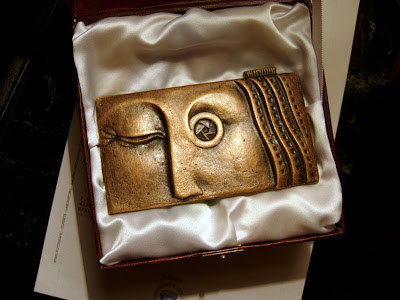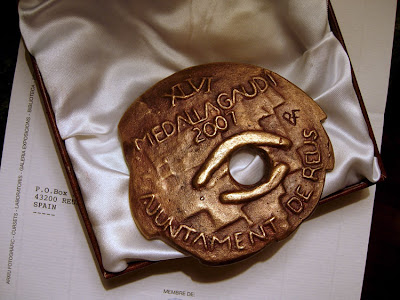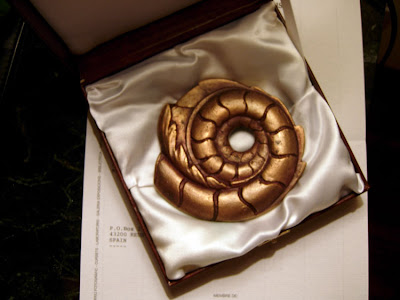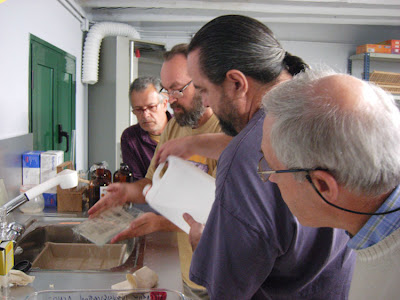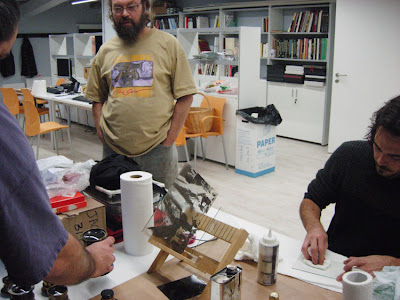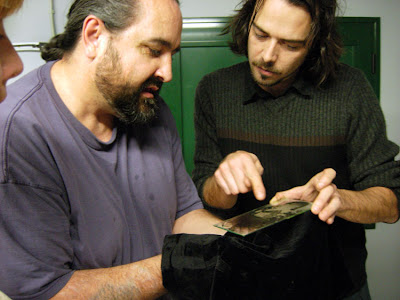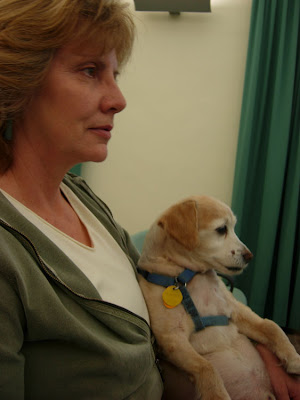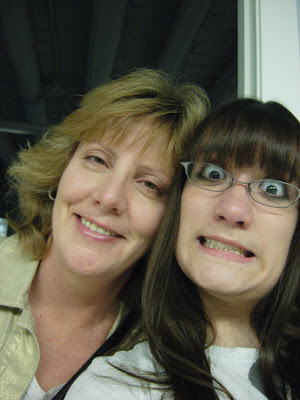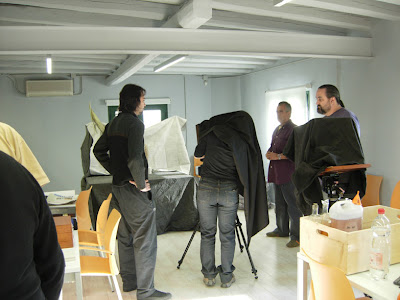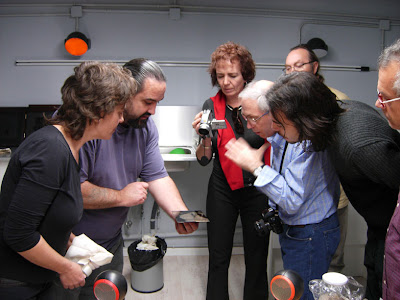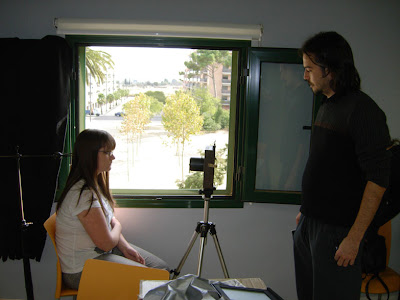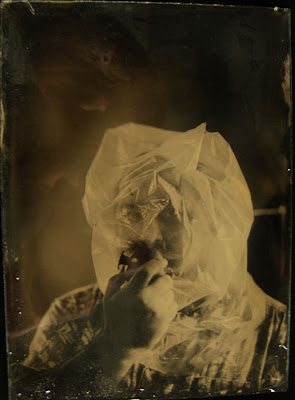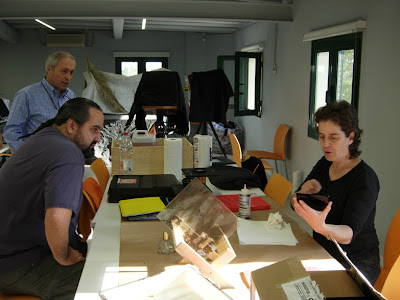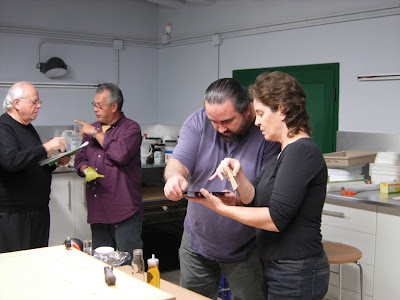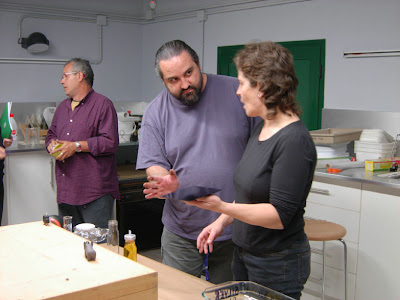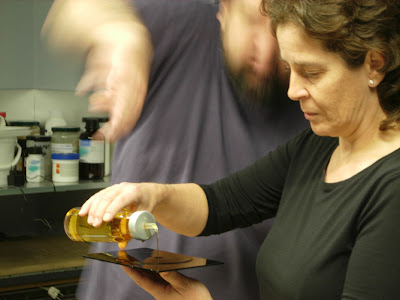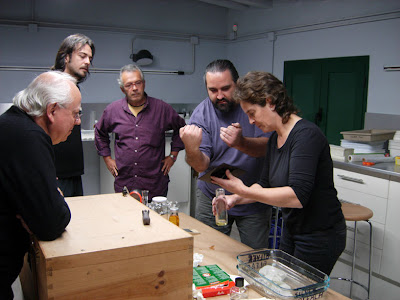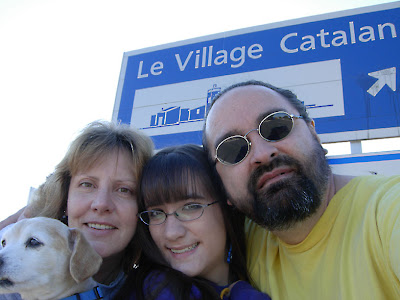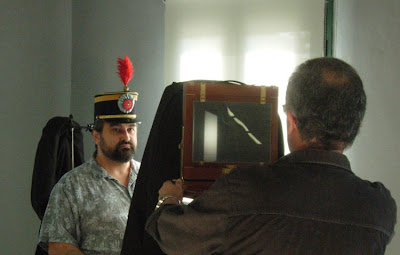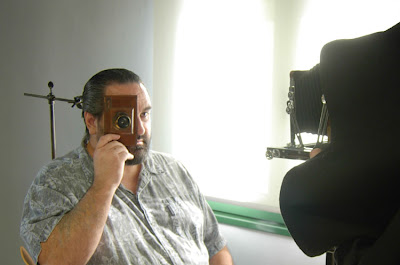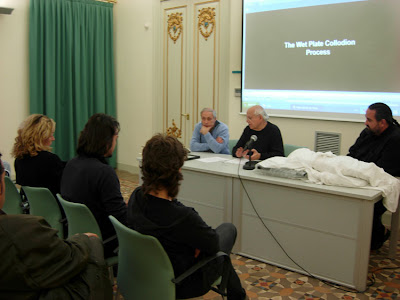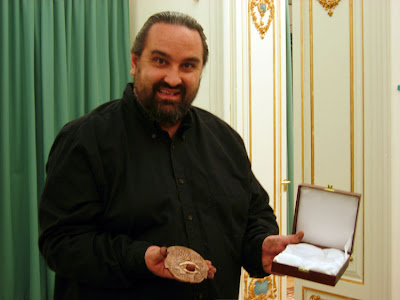 Anne Frank ExhibitOn Sunday, Jean, Summer, Denise and I jumped on the Straßenbohn and went into Mannheim. We walked around and enjoyed the people - pure C-A-N-D-Y, very delicious. There were two young German girls that came running up to us saying, "Engländer, Engländer!" I wasn't quite sure what to make of them. They were probably about 12 or 13 years-old. At first, they seemed to be interested in Summer's Converse bag. We finally realized that they were doing a project for their English class; they wanted to record us speaking English. Once I understood that, I told them to get their recorders ready - and then I said, "I want to know why more Germans can't be as friendly as you are and why they don't remember Kristallnacht here in Germany." I can't wait until their teacher translates that for them - maybe it will start a dialogue! They were puzzled but immediately played it back and were listening to it as we walked away. Several minutes later, they caught up to us again and had us clap (applause) into their recorders - we happily obliged. We were speaking in German and asking them to say "Hallo" to German people as they walked by and to see how many responded positively - few did - it was an amazing, quick sociological experiment and those girls gave me hope for the future of Germany.
Anne Frank ExhibitOn Sunday, Jean, Summer, Denise and I jumped on the Straßenbohn and went into Mannheim. We walked around and enjoyed the people - pure C-A-N-D-Y, very delicious. There were two young German girls that came running up to us saying, "Engländer, Engländer!" I wasn't quite sure what to make of them. They were probably about 12 or 13 years-old. At first, they seemed to be interested in Summer's Converse bag. We finally realized that they were doing a project for their English class; they wanted to record us speaking English. Once I understood that, I told them to get their recorders ready - and then I said, "I want to know why more Germans can't be as friendly as you are and why they don't remember Kristallnacht here in Germany." I can't wait until their teacher translates that for them - maybe it will start a dialogue! They were puzzled but immediately played it back and were listening to it as we walked away. Several minutes later, they caught up to us again and had us clap (applause) into their recorders - we happily obliged. We were speaking in German and asking them to say "Hallo" to German people as they walked by and to see how many responded positively - few did - it was an amazing, quick sociological experiment and those girls gave me hope for the future of Germany.
We were hungry after all of this and had lunch at a Turkish Döner. Ein Der Turkei Pizza mit Lamm Fleisch (Döner) rocks!! I had the Turkish buttermilk called, "Arayan" - it's a cross between buttermilk and yogurt drink, very popular with Turkish people and very tasty. After lunch, we headed to the synagogue to see the Anne Frank exhibit.
Although we went to the Anne Frank Haus in Amsterdam in 2001, her story never ceases to amaze me, lift me up and sadden me all at once. It's like she knew that she wasn't going to live very long. Her passion and dreams were waiting to be realized, but were dashed and destroyed by insane, possessed people. I hope she can see the positive influence her work and life has had, and will continue to have, on people all over the world. She was an amazing human being.
Flowing a Glass Plate With Collodion
Kristallnacht 2008
This November 9th (and 10th) is the 70th Anniversary of Kristallnacht, or "The Night of Broken Glass." Almost 2000 synagogues were desecrated or destroyed. I'm hoping to have a body of work (wet plate collodion images - photographs on glass plates) to exhibit in Germany on one, or both, of these nights.
I'm well on my way to getting my project started (the actual image making part). For the last several months, I've been doing a lot of research. My point of view and opinion about this event has changed a lot. It's one thing to understand an event like this in the abstract, quite another to walk this land, see these places and, in a lot of ways, feel the misery and hurt of the people murdered here - it changes you.  Viernheim Memorial
Viernheim Memorial
This is the Viernheim, Germany memorial. I live in this village. This memorial is a five minute walk from my house. To me, this looks like a tombstone. The wet plate collodion process has also created a visual that looks like fire below it. The background is "spinning" because of the old lens I'm using - it's pregnant with metaphor.
The work that I am creating now will be more "radical" and more conceptual than this. Not that there is anything wrong with "documents," I just want to say more visually. Let's see if I can make it happen.
The Dachau Concentration Camp
"Arbeit Macht Frei": The Dachau Concentration Camp
22 December 2007
Words seem so weak and meaningless when I think about how to describe our visit to Dachau’s concentration camp Saturday.
Even that sentence seems trite and cliché – “Oh yeah, the Holocaust, sad, terrible, blah blah blah, we’ve heard it all before.” I recently wrote a paper about my Kristallnacht project and it begins like this:
“Ian Kershaw said, 'The road to Auschwitz was built by hate, but paved with indifference.’ The Holocaust is a topic most people prefer to know only superficially, or to ignore altogether. I believe that an understanding of its complexity, as well as its violence, is critical to an understanding of our world and our humanity”.
I believe this is how most people respond to or think when the topic of the Holocaust is brought up. Most Americans feel like they have "Holocaust Fatigue" (and you can imagine how the Germans feel).
It’s not that people don’t think that it was tragic and terrible; it’s that they don’t really understand how tragic and terrible it was and what that means to them today (i.e. losing personal freedoms and all those slippery political slopes we seem to find ourselves on lately). There is relevance and meaning in these events that we need to talk about and keep alive; both for the victims and for our own lives; politically and personally.
Munich (München) is about 200 miles southeast of us. It should be a little less than 3 hours to drive there. However, on Saturday, it took us over 4 hours because of “Staus” or traffic jams. Dachau is about 10 miles outside of Munich. It’s where the concentration camp is located and where we stayed.
When we arrived, we checked into the hotel and dropped off our (minimal) luggage. We stayed in nice place called Central Hotel Dachau. Denise was kind enough to pay for the rooms (thank you!) We only spent a few minutes in the room(s) and we were off to see the concentration camp. It was amazing to me that the camp was only 1.5 kilometers outside of the city! I was blown away! I thought about the crematorium and the ashes that must have fallen on Dachau, unbelievable.
It took less than 5 minutes to drive to the parking lot of the concentration camp (it’s weird to say that). We got out of the car and started unloading and getting dressed for the weather. Summer mentioned something about the smell. I could smell something like old onion soup and tin or metal. I thought it smelled kind of like body odor. She agreed and said that she was about to gag. Jean and Denise said they couldn’t smell it. We could smell it again outside of the barracks area. Later on, we realized that it got into our clothes (like smoke) and we could all smell it. It wasn't a good smell and we're not sure what it was.
It was very cold there Saturday – a damp cold. It was foggy and bleak too. The first time I realized that I was really there was when I saw that infamous, “Arbeit Macht Frei” slogan on the gate. What an insult this is – I could picture thousands of prisoners being marched in and out of that gate everyday to forced road marches, meaningless labor and ultimately death. That phrase must have haunted them.
The moment I walked through the gate, there was an eerie silence and expanse of space that was cold and gray. I immediately felt very alone. In fact, I felt an overwhelming sense of loneliness. I felt abandoned, scared and very small at that moment. I’m not easily spooked, but this place scared me in a weird, surrealistic way. It was very quiet. The only thing I could hear was the sound of my shoes crunching along the gravel with each step I took. I couldn’t feel my legs and I felt hollow, or outside of myself somehow. All of a sudden, a scene of isolation ran through my mind. I “saw” and “heard” static and then I “saw”, or felt, myself standing in a cold snow-drifted land with the wind rushing across my body. It was like a scene from a movie. I was standing at the far right of the frame facing the viewer and wind was blowing hard from my left. I just stood there looking into nothingness. The feeling of expanse, abandonment and loneliness never left me.
To go into details of what we saw wouldn’t do them justice. I even had second thoughts about writing anything about our trip. It’s safe to say that it was emotional and moving to be in a place where so many people lost their lives in such terrible ways.
For the first time in my life, I’m beginning to understand why it’s so important to remember. Why memory is so crucial to our progress. We truly are destined to repeat these kinds of things if we don’t. This is probably my favorite image I shot there. This beautiful red rose, covered in frost and dying, lying on a box of ashes of some of the victims of Dachau. The wall says, "Never Again" in five different languages. That is the message I got - to keep these memories alive. The stones are from Jewish people that have visited and placed a stone on the box of ashes as a symbol of erecting a tombstone for the dead.
This is probably my favorite image I shot there. This beautiful red rose, covered in frost and dying, lying on a box of ashes of some of the victims of Dachau. The wall says, "Never Again" in five different languages. That is the message I got - to keep these memories alive. The stones are from Jewish people that have visited and placed a stone on the box of ashes as a symbol of erecting a tombstone for the dead.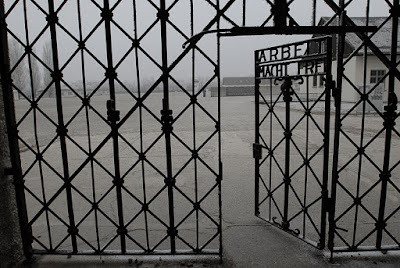 The infamous gate - "Arbeit Macht Frei" - I will never think about that phrase the same way again.
The infamous gate - "Arbeit Macht Frei" - I will never think about that phrase the same way again.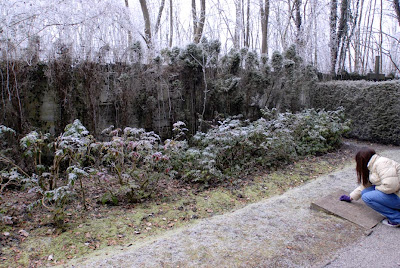 The plaque says, "Execution Range with Blood Ditch". There are a couple of these on the camp. Summer is placing stones on the memorial. The "blood ditch" is right in front of the plaque.
The plaque says, "Execution Range with Blood Ditch". There are a couple of these on the camp. Summer is placing stones on the memorial. The "blood ditch" is right in front of the plaque.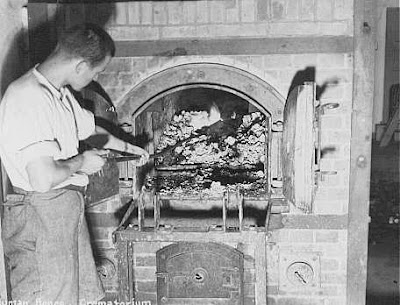 A photo shot in 1945 right after the liberation of Dachau showing the remains of some of the victims. They could fit up to 9 bodies in these ovens. Nine people? Can you imagine how emaciated the people were?
A photo shot in 1945 right after the liberation of Dachau showing the remains of some of the victims. They could fit up to 9 bodies in these ovens. Nine people? Can you imagine how emaciated the people were?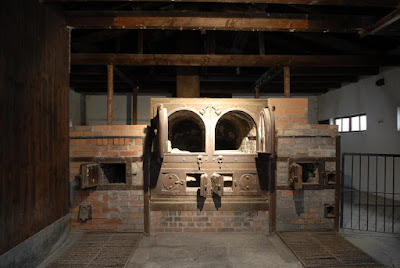 These ovens WERE USED to cremate people. This is in the "old" Crematorium.
These ovens WERE USED to cremate people. This is in the "old" Crematorium. 
In so many ways, this is what Dachau felt like to me.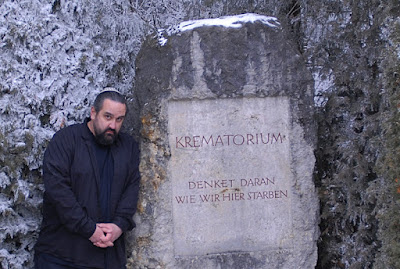 I was very moved by this memorial - "Crematorium - Remember How We Died Here"
I was very moved by this memorial - "Crematorium - Remember How We Died Here"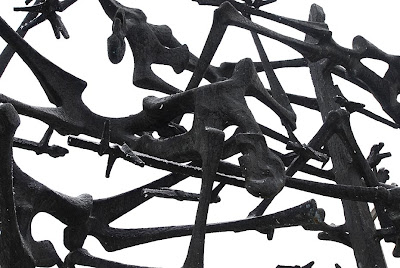 The (very moving) sculpture in the center of the camp by the artist, Nandor Glid. The emaciated bodies entangled with barbed wire - It says, "Forgive, but never forget".
The (very moving) sculpture in the center of the camp by the artist, Nandor Glid. The emaciated bodies entangled with barbed wire - It says, "Forgive, but never forget". This is the ONLY color in the camp. It's a bas relief that shows the different "badges" worn by the camp's prisoners. Jews, A-socials (Gypsies), Homosexuals, Jehovah Witnesses, and Political and Religious prisoners all had different symbols and color combinations of symbols in order to quickly identify their "crimes". The piece is three links of chain connected by bars with the badges on/around each chain.
This is the ONLY color in the camp. It's a bas relief that shows the different "badges" worn by the camp's prisoners. Jews, A-socials (Gypsies), Homosexuals, Jehovah Witnesses, and Political and Religious prisoners all had different symbols and color combinations of symbols in order to quickly identify their "crimes". The piece is three links of chain connected by bars with the badges on/around each chain.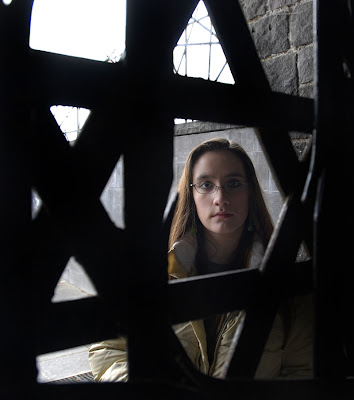 Summer peering into the Jewish Memorial on the far south side of the camp.
Summer peering into the Jewish Memorial on the far south side of the camp.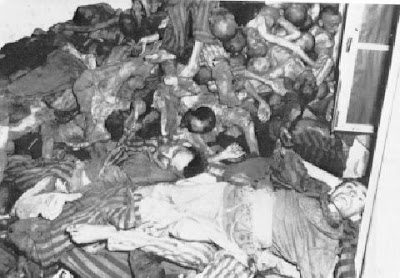 These were the victims found in the room I photographed below. This is just mind blowing to me!
These were the victims found in the room I photographed below. This is just mind blowing to me!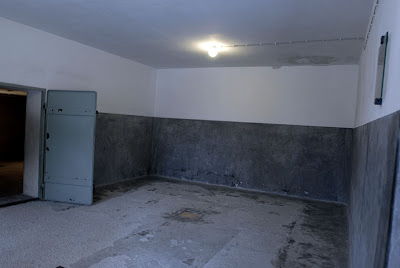 This is the room where the (above) victims were piled up. It was cold and eerie. The whole thing was surreal.
This is the room where the (above) victims were piled up. It was cold and eerie. The whole thing was surreal.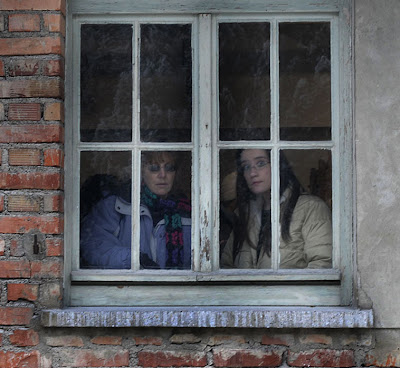 Jean and Summer peer through the window inside the (new) Crematorium.
Jean and Summer peer through the window inside the (new) Crematorium.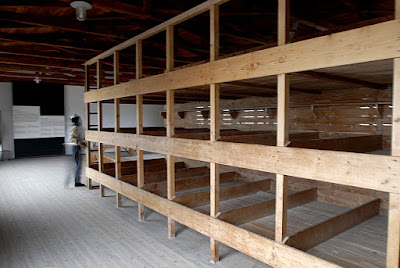 The barracks - rebuilt in 1964. It was amazing how strict the SS was on the cleanliness and order of the barracks - just another testament to the sickness of it all.
The barracks - rebuilt in 1964. It was amazing how strict the SS was on the cleanliness and order of the barracks - just another testament to the sickness of it all.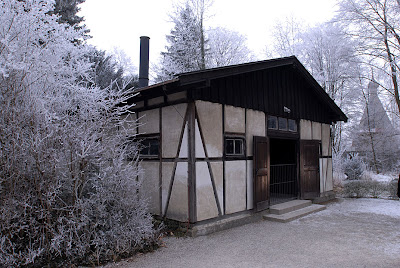 This is the "old" Crematorium directly across from the "new" one.
This is the "old" Crematorium directly across from the "new" one. Bodies in front of the "old" Crematorium (see photo above this) in 1945. Obviously, these victims were going to be cremated.
Bodies in front of the "old" Crematorium (see photo above this) in 1945. Obviously, these victims were going to be cremated.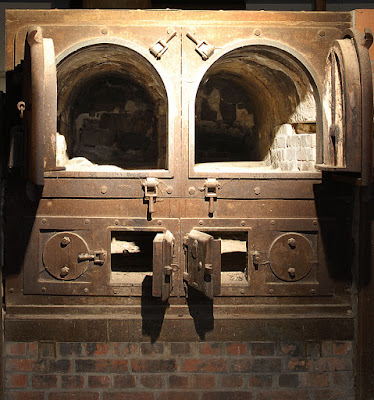 Detail of the (used) ovens in the "old" Crematorium.
Detail of the (used) ovens in the "old" Crematorium.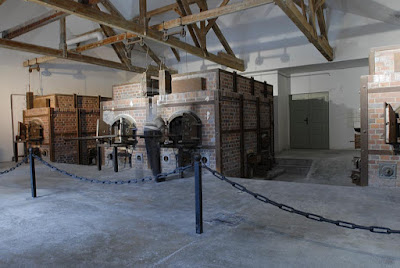 Denise looking into one of the ovens of the "new" Crematorium.
Denise looking into one of the ovens of the "new" Crematorium. Electric fence and guard tower. I wonder how many died on these fences?
Electric fence and guard tower. I wonder how many died on these fences?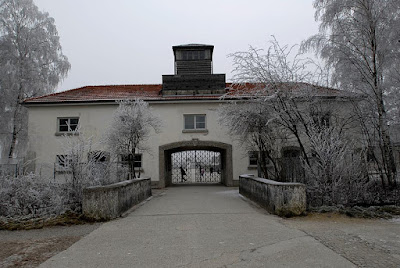 Entering into the concentration camp at Dachau.
Entering into the concentration camp at Dachau. I'm at one of the "Execution Ranges with Blood Ditch". I wanted to stand there to see what it felt like. I was looking for bullet holes in the concrete.
I'm at one of the "Execution Ranges with Blood Ditch". I wanted to stand there to see what it felt like. I was looking for bullet holes in the concrete.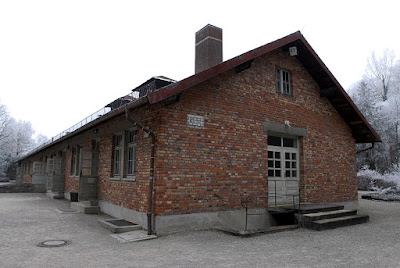
The "new" Crematorium and gas chamber building.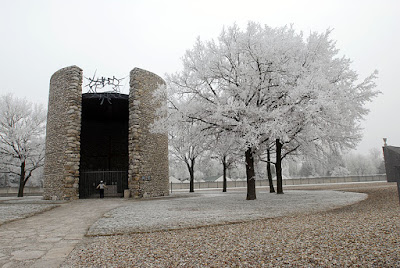 2/3 of all of the prisoners were non-Jewish, political prisoners with Polish Catholics in the majority. 1034 Catholic Priests died at Dachau. This is a memorial to them.
2/3 of all of the prisoners were non-Jewish, political prisoners with Polish Catholics in the majority. 1034 Catholic Priests died at Dachau. This is a memorial to them. This is a gas chamber that was used at Dachau. I could barely stand up in it - it freaked me out. I was amazed that I got this image with the moving body in it.
This is a gas chamber that was used at Dachau. I could barely stand up in it - it freaked me out. I was amazed that I got this image with the moving body in it.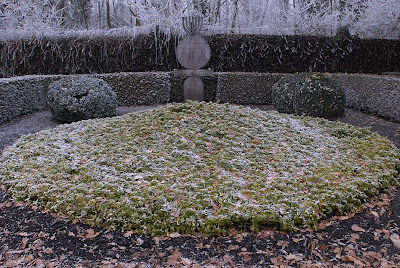 This is, "The Grave of Thousands of Unknowns" - the ashes from the Crematorium were dumped here (as well as other places).
This is, "The Grave of Thousands of Unknowns" - the ashes from the Crematorium were dumped here (as well as other places). A photo from 1945 showing the bodies of some of the victims piled outside of the Crematorium.
A photo from 1945 showing the bodies of some of the victims piled outside of the Crematorium.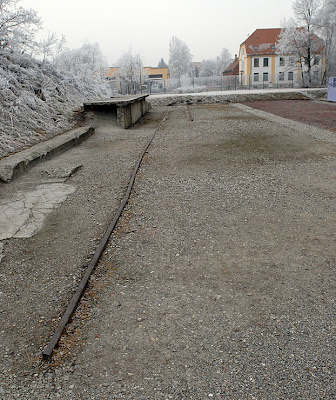 This is some of the train track just outside of the main gate.
This is some of the train track just outside of the main gate.
"Dachau can and shall be a lesson! Therefore we dare not be silent about it, although the memory of it is sad and grievous." Dr. Johannes Neuhäusler, Auxiliary Bishop of Munich and former Dachau inmate, June 17, 1960
Stars & Stripes Article and the REAL Me
(aka Ego Bohemian Post - Just for fun)


The real me. Unkempt, drinking coffee and wine and rambling about politics and art. December 1, 2007 - Viernheim, Germany
November 9th & 10th 1938
Last year in Berlin, they destoyed a Kristallnacht memorial and this year (a couple of days ago) they took a bus to Prague and wanted to march in the old Jewish Quarter there. We were there (in Prague) last year and the video footage I saw about this event was haunting. There's something strange about seeing the same places you have been full of Neo-Nazis and police. The Czech people came out in big numbers and said, "No way in hell are the Nazis going to march in the Jewish Quarter here". I wonder why the same thing didn't happen in Germany 70 years ago? This is a big quesiton for me. I'm beginning to explore it through my artwork... stay tuned.
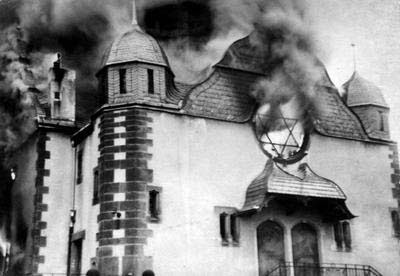
Jewish Synagogue Burns During Kristallnacht - Almost immediately upon assuming the Chancellorship of Germany, Hitler began promulgating legal actions against Germany's Jews. In 1933, he proclaimed a one-day boycott against Jewish shops, a law was passed against kosher butchering and Jewish children began experiencing restrictions in public schools. By 1935, the Nuremberg Laws deprived Jews of German citizenship. By 1936, Jews were prohibited from participation in parliamentary elections and signs reading "Jews Not Welcome" appeared in many German cities. (Incidentally, these signs were taken down in the late summer in preparation for the 1936 Olympic Games in Berlin).
Workshop in Reus, Spain
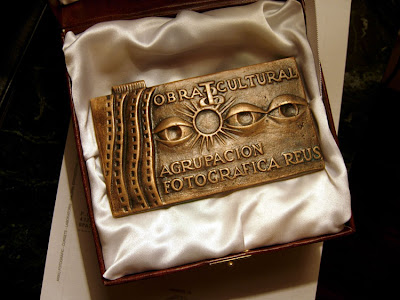
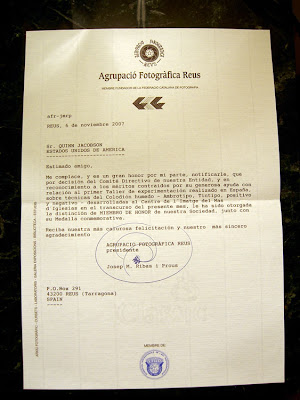
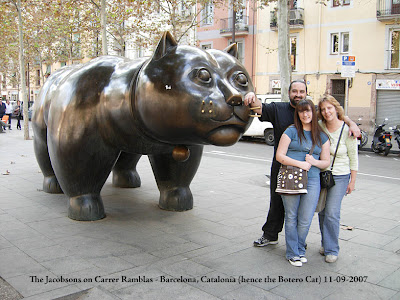
Florence, Italy
Florence's (Firenze's) claim to fame reads like a who's who from a college world history class. Da Vinci, inventor and painter. The Medicis, one of Europe's most ruthless ruling families. Danté, whose Inferno stabilized the Italian language and gave us metaphors we still use today. Savonarola, a Reformer a century too soon. Michaelangelo, history's greatest sculptor. Machiavelli, father of modern politicians. Galileo, who redefined the universe. Vespucci, a mapmaker who named a couple of continents. Artists, politicians, writers, explorers. The world would not be what it is today without Firenze. And you can feel that idea as you walk the streets of the city. It's a living, breathing city of art and history (gelato too).
We wish you all were here with us!! We are leaving Italy in the morning. We'll do a little bit of shopping today in Lucca and meet up with Fulvio this afternoon to go see some things off of the tourist track - Ciao!
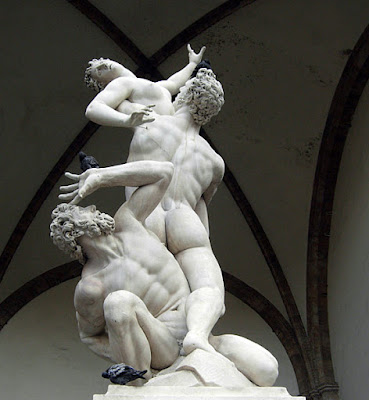 There were several works in the Piazza della Signoria that were amazing!
There were several works in the Piazza della Signoria that were amazing! Benvenuto Cellini's statue Perseus With the Head of Medusa in The Loggia dei Lanzi gallery on the edge of the Piazza della Signoria.
Benvenuto Cellini's statue Perseus With the Head of Medusa in The Loggia dei Lanzi gallery on the edge of the Piazza della Signoria. What do you think of when you think of Firenze? Michaelangelo's David has to be at the top of the list - that and the Firenze Duomo!
What do you think of when you think of Firenze? Michaelangelo's David has to be at the top of the list - that and the Firenze Duomo! We had to get get tight to get the shot, but we did it! This is the fake David, we did see the real one in the Accademia -
We had to get get tight to get the shot, but we did it! This is the fake David, we did see the real one in the Accademia - A detail of the Duomo - incredible and beautiful!
A detail of the Duomo - incredible and beautiful! The Duomo from another angle.
The Duomo from another angle.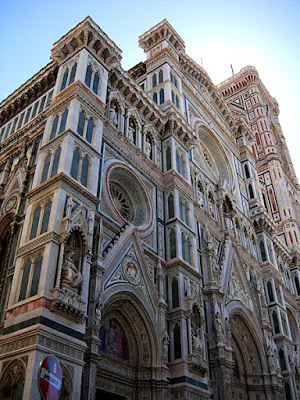
One of the most amazing sites in Firenze is the Duomo - the center of the city. It's amazing and the photographs do it NO justice. The detail and size it truly mind-blowing.
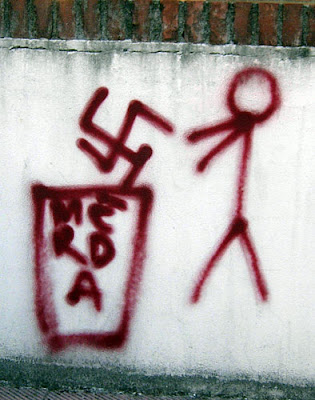 " Merda" means shit in Italian - I've always liked stick figures.
" Merda" means shit in Italian - I've always liked stick figures. Momma and Lucky on the train back to Lucca.
Momma and Lucky on the train back to Lucca. A constant reminder everywhere in Europe is that the current administration has really made it hard for Americans living (and traveling) abroad.
A constant reminder everywhere in Europe is that the current administration has really made it hard for Americans living (and traveling) abroad.
Viareggio, Italy
After the beach, we wandered the beach walk and ate lunch then did some shopping. Just a WONDERFUL time all around and a giorno bello!
 A street painter in Viareggio. It seemed he was teaching these two young ladies how to paint. It smelled wonderful.
A street painter in Viareggio. It seemed he was teaching these two young ladies how to paint. It smelled wonderful.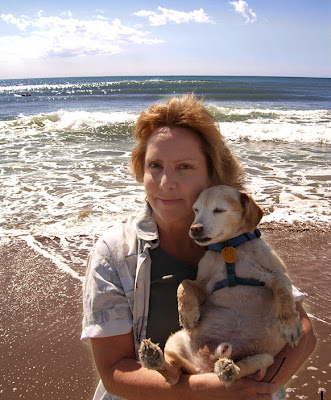 Isn't this a cute picture!!!??!!
Isn't this a cute picture!!!??!! This is the private beach we "used" - gorgeous!!
This is the private beach we "used" - gorgeous!! Another "sexy-beast" shot (at least that's what Jean calls them).
Another "sexy-beast" shot (at least that's what Jean calls them). How dramatic!! Our young Drama Queen!!
How dramatic!! Our young Drama Queen!! Is that the Med Sea behind us?? Yes it is!!! (sorry Lucky).
Is that the Med Sea behind us?? Yes it is!!! (sorry Lucky). This is the play Jean and Summer went to in Firenze!
This is the play Jean and Summer went to in Firenze!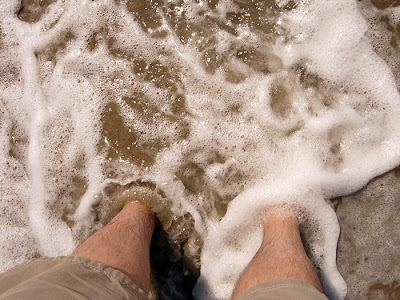 This is the way to live!! Bella, Bella Bella!!!!!
This is the way to live!! Bella, Bella Bella!!!!!
Italy
First, we met a friend named Fulvio Notarstefano. I know Fulvio from my wet plate photography board. He lives in Lucca. He spent the day with us. He showed us Lucca and we had lunch together. He also gave us one of his wet plate Collodion images and a nice bottle of wine (Italians are so friendly!). Lucca is beautiful (Bella Italia!) It’s very unique in that EVERYTHING is old! It’s all original stuff. The architecture is gorgeous and the little alleys are amazing.
Later, we went to the train station and got on a train to Firenze (Florence). It’s about 50 km from Lucca, but takes 1.5 hours by train because it stops a lot. Jean and Summer had tickets to the opera of La Boheme by Giacomo Puccini (Pucinni is from Lucca) at 18 Maggio street in Firenze (Florence). I watched Lucky (strolled him around the city at night) while they were at the opera. I ended up at a café (sitting outside) talking to an English couple for almost two hours. I drank a couple of glasses of “Bianco Toscono” (they even bought me one). I enjoyed it very much. Jean and Summer liked the opera too, we got back to the hotel at about 0130.
Yesterday, we drove into Pisa. It’s only six miles from where we are staying. Pisa is a great city. It’s a lot like Lucca but with the “Torre de Pisa” (Leaning Tower of Pisa). We had to get some “super kitsch” from this lady. She was about four feet tall and had huge teeth. Her “super kitsch” was cheap and interesting. Not that we like to buy kitsch, but we have made it kind of a “tradition” to buy “super kitsch” at the heavy tourist spots. As long as it’s cheap and inexpensive, we’ll buy a few pieces.
The Leaning Tower of Pisa has a big beautiful grass (park) where you can sit/lay in the shade of the tower. We “chillaxed” there for a while and then wandered down the road and found a nice café called, “De Mura da Nomma Teta” on Largo Pariascio 33/34 – Pisa. And yes, pizza and wine DO taste different (much better!!) in Italy.
 Inside one of the MANY churches in Lucca.
Inside one of the MANY churches in Lucca. I was very intriguied with several of these kinds of alleys. This has posters for a Firenze art show.
I was very intriguied with several of these kinds of alleys. This has posters for a Firenze art show. I loved these paintings you see on the churches in Lucca. They are beautiful.
I loved these paintings you see on the churches in Lucca. They are beautiful. This is one of my favorite pictures. I've made a habit of shooting portraits in these reflective disks. Left to right; Fulvio, Summer, Quinn, Jean and Lucky (below).
This is one of my favorite pictures. I've made a habit of shooting portraits in these reflective disks. Left to right; Fulvio, Summer, Quinn, Jean and Lucky (below).
The Leaning Tower of Lucky! Pisa, Italy.
 An empty street in Lucca during "siesta". Italians KNOW how to live.
An empty street in Lucca during "siesta". Italians KNOW how to live. The Jacobsons in the Torre park... no hands leaning against the tower, NO!!
The Jacobsons in the Torre park... no hands leaning against the tower, NO!! Down the road from the tower....
Down the road from the tower.... Molto bella! Italian kitsch lady! Oh, so many torres and super kitsch!
Molto bella! Italian kitsch lady! Oh, so many torres and super kitsch! Walking on TOP of the walls of the city of Lucca.
Walking on TOP of the walls of the city of Lucca. Can you guess what this is??? It's in Pisa.
Can you guess what this is??? It's in Pisa. Old bike in Lucca. I'm attracted to these views... I don't know why... they are harmless and innocuos.
Old bike in Lucca. I'm attracted to these views... I don't know why... they are harmless and innocuos. Four nuns late for church in Lucca.
Four nuns late for church in Lucca.


